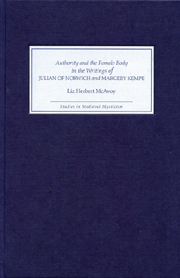Book contents
- Frontmatter
- Contents
- Dedication
- Acknowledgements
- Abbreviations
- Introduction
- 1 Motherhood and Margery Kempe
- 2 The Motherhood Matrix in the Writing of Julian of Norwich
- 3 Discourses of Prostitution and The Book of Margery Kempe
- 4 ‘3yf thowe be payede,’ quod oure lorde, ‘I am payede’: Hermeneutics of the Holy Whore in Julian of Norwich
- 5 Margery Kempe: Wisdom, Authority and the Female Utterance
- 6 Julian of Norwich: Voice of the Wise Woman
- Afterword
- Bibliography
- Index
2 - The Motherhood Matrix in the Writing of Julian of Norwich
Published online by Cambridge University Press: 12 September 2012
- Frontmatter
- Contents
- Dedication
- Acknowledgements
- Abbreviations
- Introduction
- 1 Motherhood and Margery Kempe
- 2 The Motherhood Matrix in the Writing of Julian of Norwich
- 3 Discourses of Prostitution and The Book of Margery Kempe
- 4 ‘3yf thowe be payede,’ quod oure lorde, ‘I am payede’: Hermeneutics of the Holy Whore in Julian of Norwich
- 5 Margery Kempe: Wisdom, Authority and the Female Utterance
- 6 Julian of Norwich: Voice of the Wise Woman
- Afterword
- Bibliography
- Index
Summary
[T]he gestation drive – just like the desire to write: a desire to live self from within, a desire for the swollen belly, for language, for blood.
Society and Enclosure: Maps of Experience
Aftyr this my syght byganne to fayle, and it was alle dyrke abowte me in the chaumbyr, and myrke as it hadde bene nyght; save in the ymage of the crosse there helde a comon lyght, and I wyste nevere howe. Alle that was besyde the crosse was huglye to me as 3yf it hadde bene mykylle occupyede with fendys. (ST, 42)
One could be forgiven for interpreting these disembodied words from Julian of Norwich's Revelations of Divine Love as the representation of the experiences of an anchoress following the act of enclosure. The door to her cell has been sealed and she is left with a sense of her own separation from the ugliness of the world and with an awareness of the brightness of the crucified Christ who alone remains with her. As the physical darkness of the anchorhold descends, so her consciousness begins to merge with the illuminated crucifix and we feel we are witnessing the approach to spiritual union of the anchoress with Christ. Yet, restored to its context, this passage describes not the mystical experience of the anchoress but that of a mortally ill woman of thirty whose mother has summoned the priest to deliver the last rites as her life ebbs away (41). The woman holds centre stage in this sickroom drama, her proximity to death diminishing her eyesight and paralysing her body.
- Type
- Chapter
- Information
- Publisher: Boydell & BrewerPrint publication year: 2004



